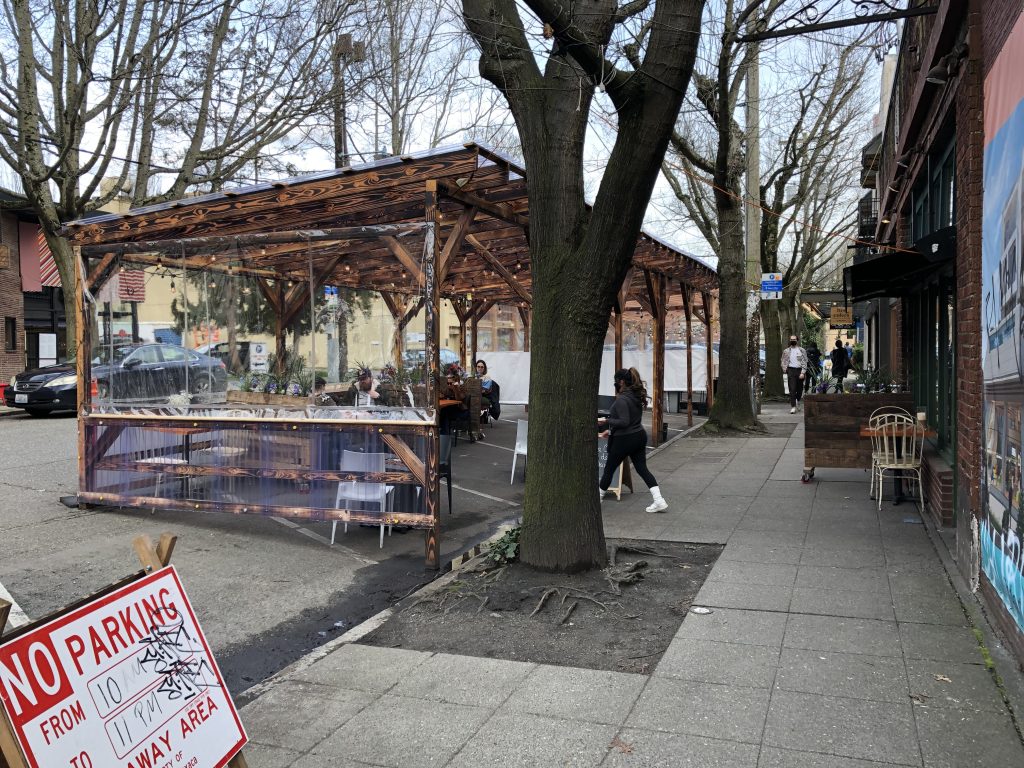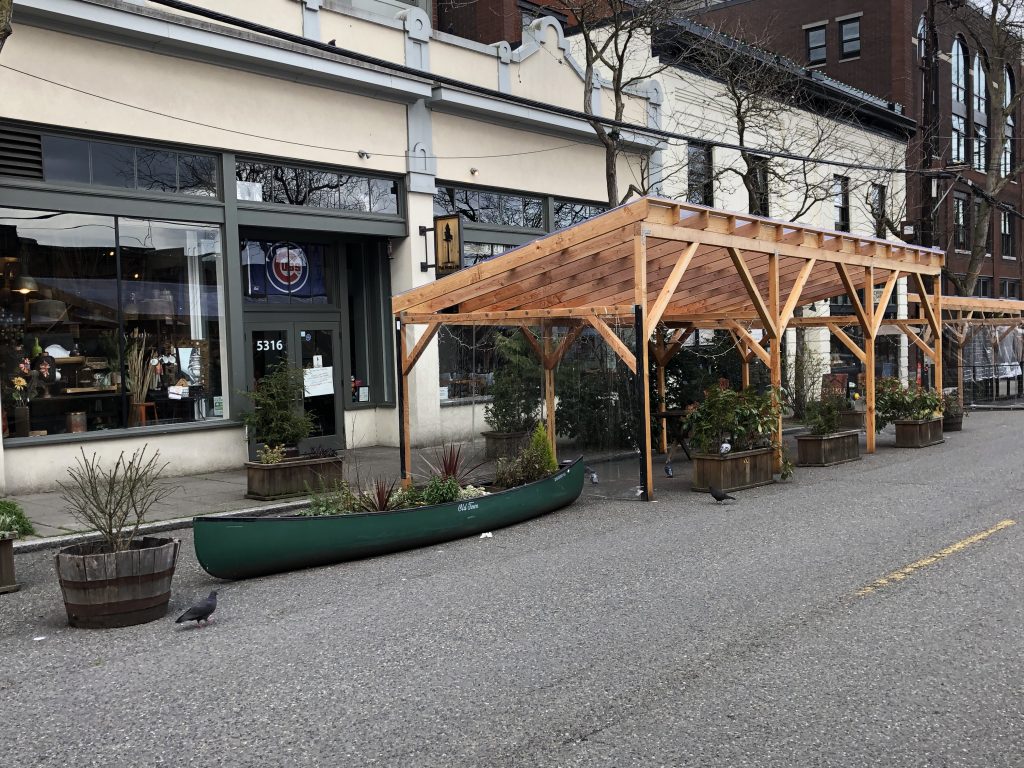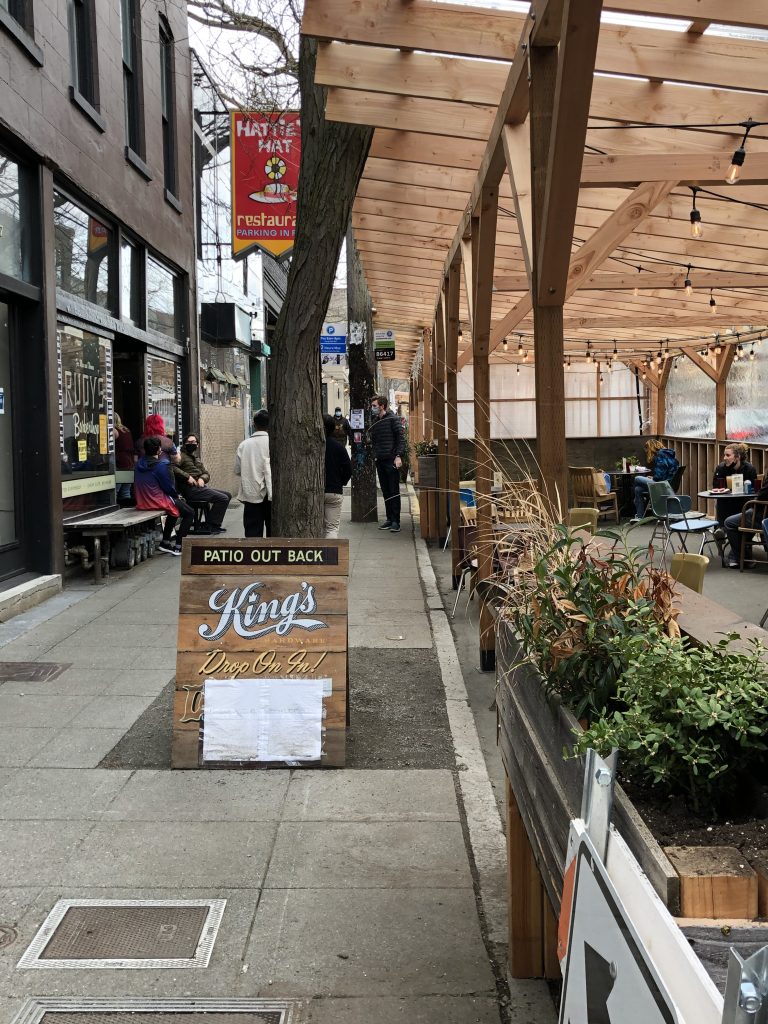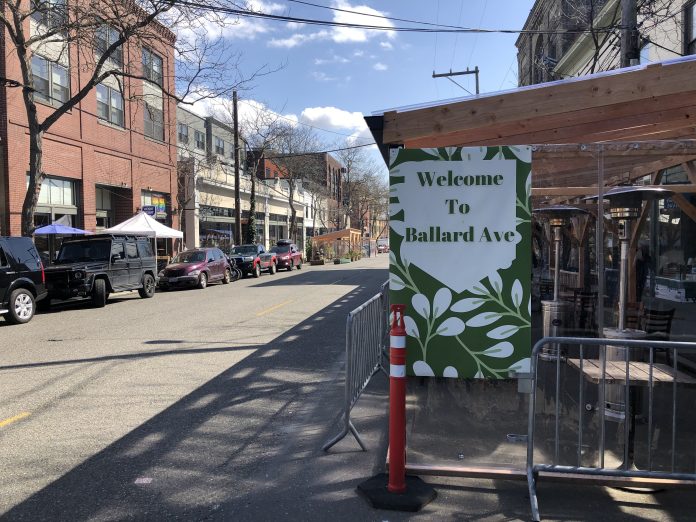Councilmember Strauss looks towards long-term café streets.
Councilmember Dan Strauss is enjoying Seattle’s outdoor dining cafe streets, even outside of his own district. “I love them. I was out at Rione XIII having dinner. It was really nice to have some semblance of normalcy while I was feeling safe in a place with public health protections.”
His meal and enjoyment are well earned, if neighborhood apostasy. The councilmember was ahead of many in City Hall asking that businesses be allowed to use nearby right-of-ways to accept guests while complying with pandemic seating limits. Last May, Strauss was at the forefront (yet still behind The Urbanist) in looking to public areas for improved public health. It took negotiating with the Mayor’s Office, the Fire Department, the Seattle Department of Transportation (SDOT), and many others through the summer for the first permits to be issued.
But even through Seattle’s notorious winter drizzle, the program has taken off. Stretches of streets in all corners of the city have been turned into lively outdoor eateries. The car lanes have been narrowed and people have taken over. Strauss shrugs off credit. “These programs have been successful because business and restaurants have been inventive and successful and have seized the opportunity at a trying time. I just got government out of the way and helping.”
And now, Strauss wants the open streets made permanent.
The pandemic has seen a couple of programs to convert car spaces to people spaces going on in Seattle simultaneously. The Stay Healthy Streets program has prioritized walkers, bikers, and rollers on neighborhood greenways throughout the city. The roads get closed to through traffic and allow for getting out and around safely distanced from others. Unfortunately, these do not connect into many of the city’s commercial areas. But, it has been promised that 20 miles of Stay Healthy Streets are here to stay — even if the funding question is lingering and could swipe other bike project funding.
Separately, the Keep Moving Streets program has opened mostly car-free streets adjacent to parks and popular outdoor locations. Two locations — Alki Way’s western tip and Green Lake Way at the southwest corner of the park — are ongoing under this program. The next Keep Moving Street will be opening Lake Washington Boulevard between Mt. Baker Beach and Stan Sayers Park during Spring Break, the week of April 9th. These are much more ephemeral, but shouldn’t be.
Perhaps the most visible open streets program has been the outdoor cafes taking over parking spaces along the more popular neighborhoods in town. Nowhere is this more successful than on Ballard Avenue in Strauss’ council district. It’s also a key to the economic recovery. “By pedestrianizing Ballard Avenue, we have enough space to have a vibrant neighborhood and a strong economy.”

It was not immediate getting here. Through fits and starts over the summer, businesses were promised and coached and then put on another lockdown before finally getting the first permits to open outdoor dining in August. Then, businesses put up more temporary structures just in time to need heaters for the fall. This ran into new issues with the fire department, who frowned upon blasting propane in vinyl tents. Last October, the program was extended through October 2021.
Strauss recognizes the long summer of insecurity. Having it to do again, “I would have gotten it started sooner. We were able to open in August. If we could open by Memorial Day, we would have had more opportunity to have more of the summer. There were still intense concerns about public health risk.”
He continues, “I also would have given businesses more assurance that investments made over this last winter would been used this summer. Made it clear these could be permanent features of our community.”
The impact of having permits for outdoor dining at least through an entire summer is very visible on Ballard Avenue right now. The first generation of moveable fences and plastic pods are being progressively replaced by more secure and more elaborate wood structures. And canoes. They are not New York’s pandemic snow shacks. What’s being built on Ballard Avenue is more uniquely Seattle. We’ve replaced blue tarp camping with cedar ceiling cafes as an outdoors calling card.

Keeping cafe streets around permanently has several moving parts. Strauss’ office is working with groups like the Ballard Alliance to get feedback from the businesses and identify the improvements to be made permanent. They will be developing a realistic timeline for getting there, making sure to get buy-in from the community and address client issues. And then that information will be presented to SDOT.
For Strauss, much of the hard work of testing and correcting has already been done over the last year. He points to some of the early hurdles with the Stay Healthy Streets. “At the very outset, the postal service said they couldn’t deliver mail. ‘No, USPS, please deliver mail!’” Some of the outdoor locations on 9th Avenue in South Lake Union had to be removed because the road was considered a through street. But it’s in no way a failure. A year of trying many different things has been a rolling test. Seeing the places cafes didn’t work emphasizes the places that do.
Places like Ballard Avenue. Strauss reemphasizes “I want SDOT to be clear that these improvements are permanent.”

Such an iterative test and try attitude has already had spin-off effects. In Greenwood, Yonder Cider opened a bottle shop in a garage next to the neighborhood’s Stay Healthy Street. The shop was shut down for a period due to complaints of having a business in a private residence. This led to Strauss and Councilmember M. Lorena González co-sponsoring the Bringing Business Home Bill. The bill changes the antiquated rules for “home occupations” — businesses someone operates out of their home — at a time when we’re doing everything in our homes. It passed in early March, Yonder Cider is reopened, and the door is open wider for many more at-home entrepreneurs.
Councilmember Strauss says it’s about government rising to the occasion. “Bringing Business Home or cafe streets, these are examples of government being responsible to survive a 100-year pandemic.”
Over the next weeks, Strauss will be looking for other projects where connecting the new ways we live and work can help keep the community physically and economically active. “It’s about community buy-in. If every neighbor on the block said we want to activate our block, let’s look at that.” At the top of the list is reopening all of the city’s farmers markets, Strauss says. “Anyway we can bring community to our streets.”
Ray Dubicki is a stay-at-home dad and parent-on-call for taking care of general school and neighborhood tasks around Ballard. This lets him see how urbanism works (or doesn’t) during the hours most people are locked in their office. He is an attorney and urbanist by training, with soup-to-nuts planning experience from code enforcement to university development to writing zoning ordinances. He enjoys using PowerPoint, but only because it’s no longer a weekly obligation.


